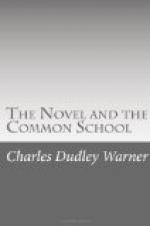When this truth is recognized in the common schools, and literature is given its proper place, not only for the development of the mind, but as the most easily-opened door to history, art, science, general intelligence, we shall see the taste of the reading public in the United States undergo a mighty change: It will not care for the fiction it likes at present, and which does little more than enfeeble its powers; and then there can be no doubt that fiction will rise to supply the demand for something better. When the trash does not sell, the trash will not be produced, and those who are only capable of supplying the present demand will perhaps find a more useful occupation. It will be again evident that literature is not a trade, but an art requiring peculiar powers and patient training. When people know how to read, authors will need to know how to write.
In all other pursuits we carefully study the relation of supply to demand. Why not in literature? Formerly, when readers were comparatively few, and were of a class that had leisure and the opportunity of cultivating the taste, books were generally written for this class, and aimed at its real or supposed capacities. If the age was coarse in speech or specially affected in manner, the books followed the lead given by the demand; but, coarse or affected, they had the quality of art demanded by the best existing cultivation. Naturally, when the art of reading is acquired by the great mass of the people, whose taste has not been cultivated, the supply for this increased demand will, more or less, follow the level of its intelligence. After our civil war there was a patriotic desire to commemorate the heroic sacrifices of our soldiers in monuments, and the deeds of our great captains in statues. This noble desire was not usually accompanied by artistic discrimination, and the land is filled with monuments and statues which express the gratitude of the people. The coming age may wish to replace them by images and structures which will express gratitude and patriotism in a higher because more artistic form. In the matter of art the development is distinctly reflex. The exhibition of works of genius will slowly instruct and elevate the popular taste, and in time the cultivated popular taste will reject mediocrity and demand better things. Only a little while ago few people in the United States knew how to draw, and only a few could tell good drawing from bad. To realize the change that has taken place, we have only to recall the illustrations in books, magazines, and comic newspapers of less than a quarter of a century ago. Foreign travel, foreign study, and the importation of works of art (still blindly restricted by the American Congress) were the lessons that began to work a change. Now, in all our large towns, and even in hundreds of villages, there are well-established art schools; in the greater cities, unions and associations, under the guidance of skillful artists, where five or six




